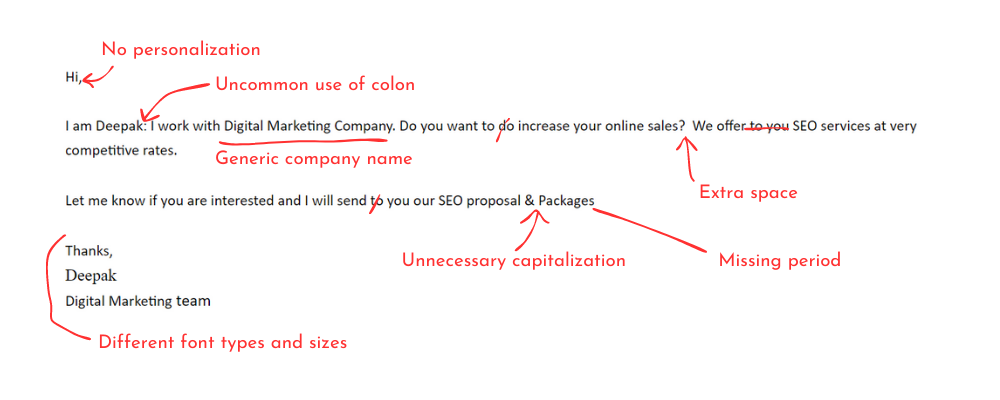
You’ve heard all the benefits of networking and you’re ready to give it a try. You create a LinkedIn profile and finally hit “send” on your first message to someone with an intriguing career path. You wait eagerly for a response. But one day turns into one week, and two weeks later, your inbox is still empty.
Did your message go through? You try again with a recruiter from a company you admire. Again, silence.
What could you be doing wrong? Is networking really worth your time?
Networking is worth your time, when you do it right.
It’s nothing personal if someone doesn’t reply to you. Most of the time, they’re just busy! They see a message pop up on their phone screen, and within milliseconds decide that it looks like the other dozens of messages filling their inbox each day. Their fingers automatically hit the delete button.
In order to get a response, you must stand out against the noise of common spam messages. How do you do that? Network like you’re human.
Show your humanness through your writing. And do it quickly because people are distracted. Here are some dos and don’ts to help you grab the attention you want.
How to network like you’re human: Be friendly, professional, and personal in your communications.
It’s easy to say no to a generic spambot, but it’s much harder to say no to a specific human being with feelings, hopes, and dreams. Keep this in mind when you’re crafting your next outreach message.
Just take a look at these 3 messages that came through my LinkedIn inbox.

Jennifer, Urooj, and Maya all start their messages with the same opening lines:
Hope you are doing good.
I’m delighted to connect with you. Your pursuit of success as a self-employed professional is a story that I find truly relatable.
Curious, right? I definitely ignored those messages.
What you can learn from this is that:
- Spambots are real and annoying.
- If you sound generic like a robot, you’re instantly ignored.
I know it can be tricky to convey your humanness when you’re just communicating by text. Tone of voice can be lost and you don’t want to overcompensate with too many emojis. So let me explain what you can do to network like you’re human, and not a spambot.
1) Write to be friendly
I recently received an outreach message about Virtual Assistant services. The message came off as friendly and professional. It was so well written that I accepted the connection request, but I didn’t immediately reply because I didn’t need VA services immediately and there was other stuff going on in my life. After a week, I received a follow-up message which simply said, “Are you there?“
I understand that’s probably a sales tactic to get my attention, but honestly, it just came off as rude. I waited to see if this new connection of mine would offer additional value or a personalized message to learn more about my current business needs. But no, there was no further communication. I have since removed this connection from my LinkedIn network.
If you are the person reaching out in a networking attempt, please remember that you’re asking for a favor. You’re asking someone to share their time, knowledge, connections, or whatever it may be. Use language to show respect.
However, don’t be too formal either. I live in Canada and there’s no need to use terms like “Dear Sir/Madam” because that comes off as stuffy and old-fashioned. As a general rule for online networking in North America, use a casual tone.
- Instead of: Are you there?
- Try: Hope you’ve had a great week! Following up on my message last week, I wonder if __fill in the blank__? (example: I wonder if you would be interested in learning how a Virtual Assistant can support your business)?
- Instead of: Ma’am, may I ask you a question? I would be indebted to you for offering your wisdom.
- Try: Hi Crystal! [skip the fluff and get to the point] (example: I’m new to Vancouver and I’m looking to meet more people in product management. Would you be up for a virtual coffee chat to connect over our PM experiences?)
2) Write to be professional
As you infuse a friendly tone of voice, be sure to stay professional too. Being professional can be broken down into 2 parts: the mechanics of your writing, and your relational approach.
How to be professional in your writing
The mechanics of your writing refers to the care you put into checking your spelling and grammar. When you send a message with random capitalization, missing punctuation, and incorrectly spelled words, you can raise someone’s spam alarm.
Why? Let’s take a look at this real spam message from my email inbox.

The message is littered with writing errors. And because these errors are so common in spam messages, the mind can (incorrectly) jump to conclusions when encountering other messages with similar mistakes. The good news is that it’s very easy nowadays to use free tools to spruce up your writing. Gmail comes with spellcheck in the email composer, and you can use a tool like Grammarly to check for grammar and tone of voice.
So the next time you get ready to press send on a message, check for these common writing errors first:
- Spelling
- Grammar
- Extra spaces
- Missing punctuation
- Unnecessary capitalization
- Inconsistent font styles
How to be professional in your relationship
In networking, you’re asking for as a favor. Show gratitude for every bit of information someone shares with you! Remember, they could have ignored you completely. Even a reply to say they’re not the person to talk to is a gift to you. You can move on.
Last year, someone had reached out to me on LinkedIn to inquire about a position at the company I was working at. The role they were interested in required excellent communication skills and I thought the outreach message was succinct, friendly, and personal. I responded and agreed to answer a few questions.
After I answered the questions, there was not a single word of acknowledgement. I actually went a step further and tried to probe and understand that person’s career goals to see if I might put in a good word for them. But since they didn’t reply, I had nothing to work with. This person missed a valuable chance to develop a long-term relationship with me. Even if that role didn’t work out, I would have kept my eyes open for other roles that could be a fit had I gotten to know them better.
The next time you engage in a conversation with someone, treat them the way you would want to be treated. That’s the essence of what it’s like to network like you’re human.
- Show appreciation and say thank you.
- Follow up on points discussed to show you listened and to maintain a connection.
- Follow through on actions. Never book an informational interview and then not show up! I have seen this happen and it burns bridges. That’s leaves you in a worse position than not networking at all.

3) Write to be personal
Bots send the same message to thousands of people, so they always sound generic. You should take the opposite approach and send a personalized message to each person you connect with.
Learn about your outreach target by reviewing their LinkedIn profile. See what their company does and what their role is that work. Do a quick Google search to see if anything interesting comes up. Notice any non-work interests and activities. Then, start to craft a message that connects the dots between you and them.
- Address them by their first name
- Share a little bit about yourself to start a connection
- Mention why you’re reaching out to them specifically
- Describe what you want
This can be done in as little as 3 sentences. Here’s an example:
Hi Charlie! I’m a new MBA grad with prior experience working in Asia. I’m looking to find my first job in Canada and I see that you’ve successfully transitioned from banking in Singapore to Canada. Would you be willing to share your experience over a cup of tea?
It doesn’t take much to add a personal touch, so try it with your next outreach!
It’s not hard to network like you’re human when you pay attention to the details.
I shared examples of my own encounters with spam and networking lost opportunities to highlight how being friendly, professional, and personal can make or break a connection.
It’s now your turn to take a look at spam messages in your inbox. What mistakes do you see them make? What caused you to instantly recognize them as spam? Now that you’re more aware, you can avoid the same mistakes!
If you’d like an external opinion on how you can improve your networking approach, then book a coaching call with me. I’d be happy to review your recent outreach messages and share feedback on how you can rewrite them to be more effective.
Feature photo by Eye for Ebony on Unsplash
Crystal Lee, MPH, CPCC is a holistic career coach who helps mid-career professionals transform their work and life with clarity, confidence, and kindness. Let her know if you have a career question and join her newsletter to get the answer!
Stay in the know
Join my newsletter to get career resources, inspiration, and updates!